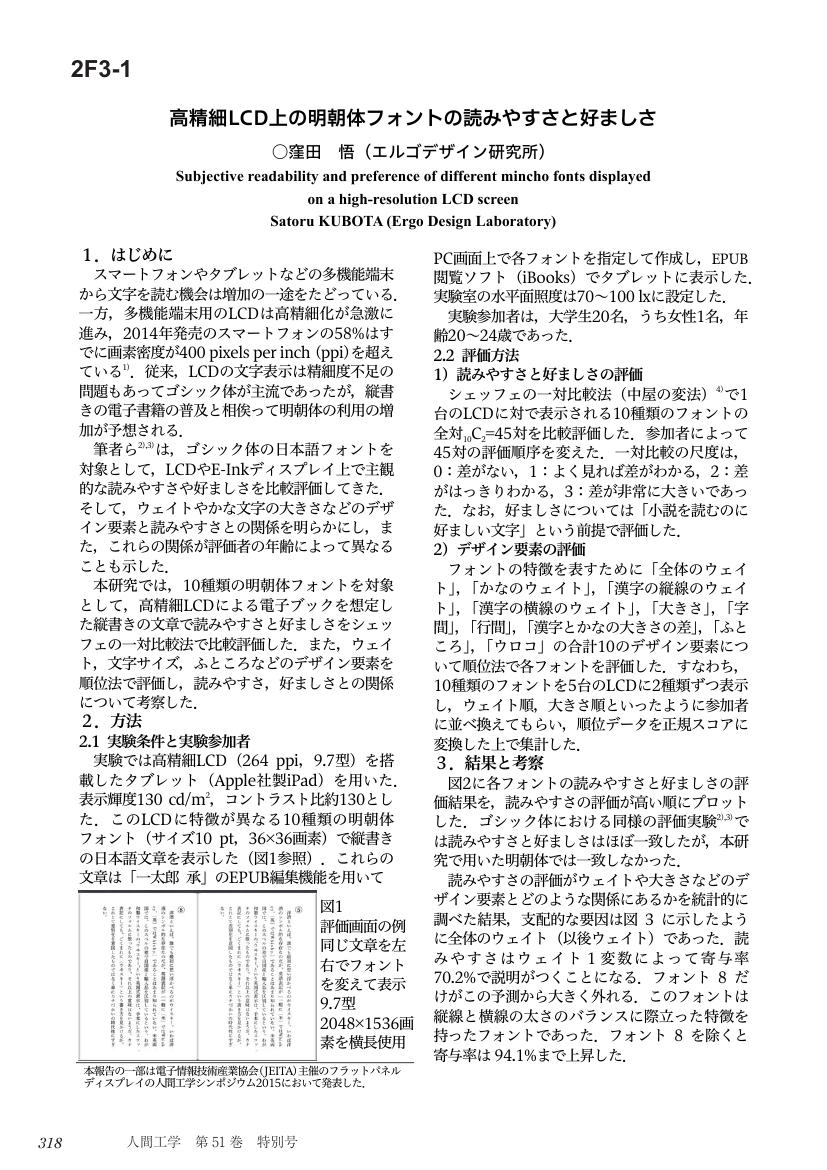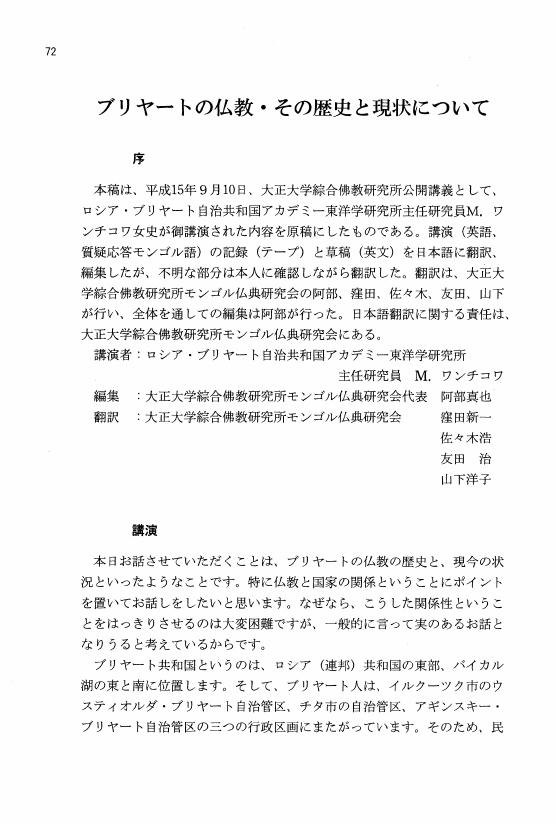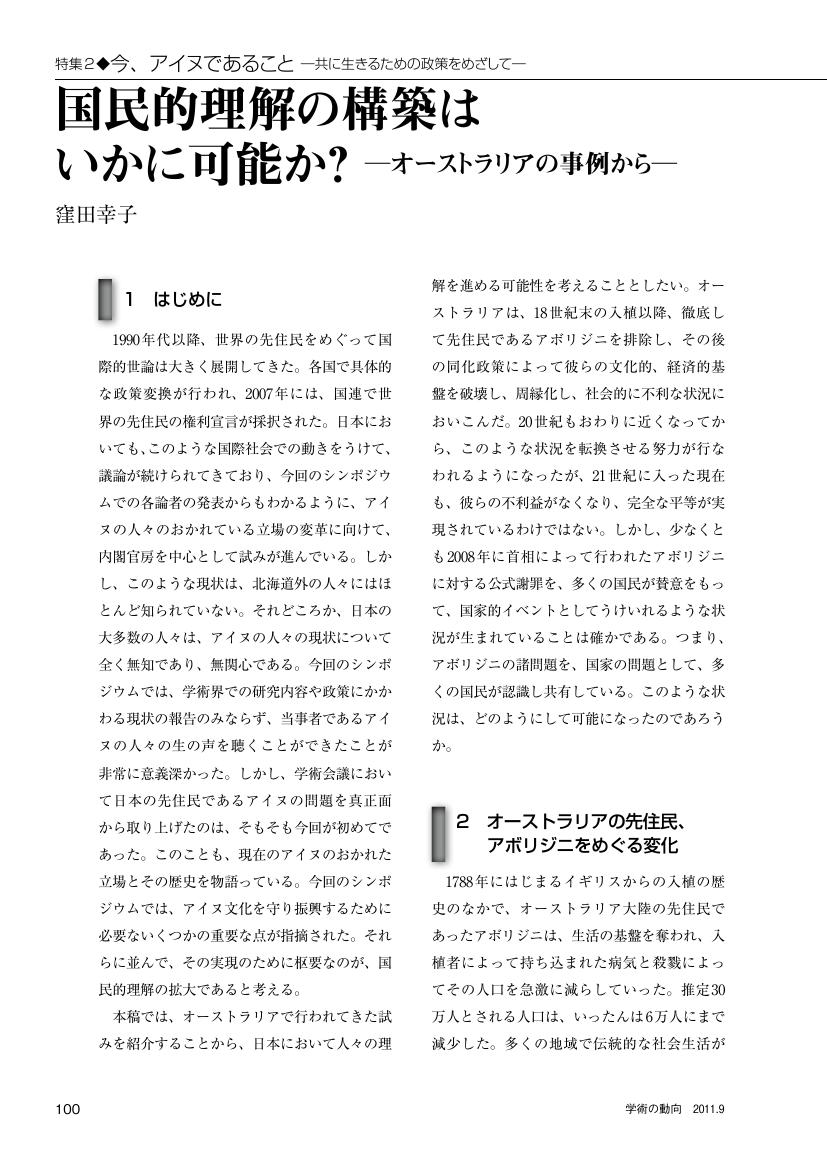61 0 0 0 秋田大学皮膚科における幼虫皮膚爬行症28例の臨床的検討
- 著者
- 河村 七美 出光 俊郎 安齋 眞一 岡田 理 窪田 卓 米田 耕造 藤田 幸子 吉村 堅太郎 真鍋 求
- 出版者
- 公益社団法人 日本皮膚科学会
- 雑誌
- 日本皮膚科学会雑誌 (ISSN:0021499X)
- 巻号頁・発行日
- vol.113, no.4, pp.389-397, 2003-03-20 (Released:2014-12-13)
組織切片から虫体を同定し得た幼虫皮膚爬行症2例を報告し,その2例を含む当教室における過去6年間の幼虫皮膚爬行症28例について臨床統計学的検討を行った.1995年4月から2001年3月までの6年間の当教室における幼虫皮膚爬行症患者は28例で,初診時年齢27歳から76歳(平均50歳),男女比は4:3(男16例,女12例)であった.発症時期は28例中25例が10月から1月の秋冬期であり,これは八郎潟のシラウオ漁解禁の時期にほぼ一致している.食歴では28例中21例(75%)で八郎潟産のシラウオ生食が認められた.以上のように発症時期や食歴より秋田県における幼虫皮膚爬行症は,その感染源として今まで報告の少ない八郎潟産のシラウオが関与していると推測される.
- 著者
- 小野田 慎平 西脇 裕作 窪田 裕大 大島 直樹 岡田 美智男
- 出版者
- ヒューマンインタフェース学会
- 雑誌
- ヒューマンインタフェース学会論文誌 (ISSN:13447262)
- 巻号頁・発行日
- vol.23, no.2, pp.213-226, 2021-05-25 (Released:2021-05-25)
- 参考文献数
- 30
In terms of communication robot, they can affect human communication through their behavior and expression; they are not just a machine but have the potential to make communication diverse. Most of the research on human-robot interaction so far focused on one-to-one interaction between humans and robots; communication robots often need to be fluent and perfect. On the other hand, we focus on the fact that our daily conversations are never perfectly conceived but contain incomplete statements in places due to the constraints of the cognitive resource. The incompleteness is often perceived as a negative phenomenon, but it also has positive power. The authors proposed an interaction design, focused on "forgetting" which is one of the incompleteness and developed the robot, Talking-Bones, that sometimes forgets words. Talking-Bones where the robot aims to communicate with humans in conversations recalling together. Talking-Bones shows encouraging behaviors by forgetting some words in a story and asking humans to help recalling the words together to continue telling the story. We conducted fieldwork to observe the interaction between children and Talking-Bones. These results illustrate how collaborative interactions are formed depending on the relationship of the children due to a forgetful robot.
35 0 0 0 シャーロック・ホームズの想い出:金縁の鼻眼鏡
27 0 0 0 OA 『神皇正統記』の執筆意図 : 北畠親房研究ノート 1
- 著者
- 窪田 高明
- 出版者
- 神田外語大学
- 雑誌
- 神田外語大学日本研究所紀要 (ISSN:13403699)
- 巻号頁・発行日
- vol.3, pp.1-19, 2002-03-31
21 0 0 0 OA テレワークと温泉熱利用による環境負荷低減効果の検証: 鳴子地域のケーススタディ
- 著者
- 鈴木 杏奈 長谷川 諒 稗貫 峻一 窪田 ひろみ 伊藤 高敏
- 出版者
- 日本地熱学会
- 雑誌
- 日本地熱学会誌 (ISSN:03886735)
- 巻号頁・発行日
- vol.44, no.3, pp.111-122, 2022-07-25 (Released:2023-01-25)
- 参考文献数
- 35
Geothermal potential area in Japan has been depopulated recently, and there have been distances between the geothermal potentials and most energy consumers living in urban areas. Since 2020, working from home (home-based telework) has spread rapidly due to the influence of the COVID-19. If some of the energy consumers work from the geothermal potential area, namely onsen areas, it would help to reduce the extra fossil fuel consumption, to reduce the environmental impact, and to save commuting costs and time. In this study, we quantitatively evaluated the advantages and feasibility of working from onsen in Naruko area, Osaki City, Miyagi Prefecture, as a case study. The environmental effects were analyzed by using the annual CO2 emissions and the costs, based on the perspective of the form of stay and the life-cycle assessments with four scenario conditions ((a) base system, (b) home-based telework in a city, (c) onsen-based telework (using hot spring only for bathing), and (d) onsen-based telework (using hot spring for bathing and heating)). Compared to the base system, the use of public baths in the onsen area can reduce CO2 emissions by about 1/3, and the use of bathing and heating by hot springs can reduce CO2 emissions by about 1/4. In the case of a short-term stay in the onsen area, the effects of reducing CO2 emission differed depending on the area where the worker is based and the season. The results indicates that some conditions of the short-term stay may results in higher CO2 emission than when nothing is done. Therefore, we expect that each of urban workers, companies, and onsen areas will change their awareness and take actions to be able to stay in the onsen area for a mid- to long-term.
- 著者
- 窪田 泰夫 森上 徹也 森上 純子 中井 浩三 横井 郁美 藤田 名都子 宗廣 明日香 前田 麗子 石川 絵美子 細川 洋一郎 小浦 綾子 米田 耕造
- 出版者
- 日本皮膚科学会西部支部
- 雑誌
- 西日本皮膚科 (ISSN:03869784)
- 巻号頁・発行日
- vol.74, no.4, pp.432-438, 2012-08-01 (Released:2012-11-15)
- 参考文献数
- 7
- 被引用文献数
- 1
アトピー性皮膚炎 (AD) 患者を対象に標準的 AD 治療のひとつとしてスキンケアにビーソフテン® ローション (B) およびヒルドイド® ローション (H) を使用し,患部皮膚の角質水分量,経皮水分喪失量の推移,AD の皮膚症状に及ぼす影響を左右半身比較による検討を行った。両製剤の使用感や利便性に関する評価と満足度も検討した。両製剤とも4,8週後に皮膚症状は有意に改善し,製剤間に差はなかった。角質水分量,経皮水分喪失量については,治療前後および製剤間の差はなかった。Visual Analogue Scale (VAS) による評価では「皮膚のうるおい」,「皮膚のなめらかさ」,「患部皮膚の色調」では,両製剤とも4,8週後に有意に改善し,製剤間に差はなかった。「痒み」は4週後では両製剤とも有意な改善を認め,8週後では (H) のみが有意に改善したが,製剤間には差はなかった。薬剤使用感のVAS評価では,「薬剤塗布時の使用感」で (B) が有意に優れていたが,「塗りやすさ」,「薬剤塗布時のにおい」,「薬剤塗布した翌朝の皮膚の状態」,「薬剤の継続使用希望」は製剤間に有意差はなかった。AD 外用治療の基礎であるスキンケアにおける保湿剤の使用は皮膚炎の軽重にかかわらず長期にわたる。患者の好み,塗布範囲,季節,発汗などに応じた剤形選択がアドヒアランス向上をもたらし,高い治療効果や QOL の改善にも寄与するものと考えられた。
17 0 0 0 OA “地方の地方”における若者の「地元つながり」 : 夕張高校OB・OG調査を基に
- 著者
- 窪田 玲奈
- 出版者
- 北海道大学大学院教育学研究院
- 雑誌
- 北海道大学大学院教育学研究院紀要 (ISSN:18821669)
- 巻号頁・発行日
- vol.115, pp.17-56, 2012-06-29
16 0 0 0 OA 2F3-1 高精細LCD上の明朝体フォントの読みやすさと好ましさ
- 著者
- 窪田 悟
- 出版者
- 一般社団法人 日本人間工学会
- 雑誌
- 人間工学 (ISSN:05494974)
- 巻号頁・発行日
- vol.51, no.Supplement, pp.S318-S319, 2015-06-13 (Released:2015-08-06)
10 0 0 0 OA 長寿二枚貝ビノスガイの殻の地球化学分析を通じた古環境復元〜海流から津波まで〜
- 著者
- 窪田 薫
- 出版者
- 日本古生物学会
- 雑誌
- 化石 (ISSN:00229202)
- 巻号頁・発行日
- vol.111, pp.5-16, 2022-03-31 (Released:2022-04-15)
Unlike the tropical to subtropical areas where reef-building corals are distributed, high latitude paleoenvironmental records with high temporal resolution over the past centuries are scarce. Long-living bivalve shells can be a good candidate for paleoenvironmental recorders. In such a situation, it has recently been revealed that modern cold-water bivalve Mercenaria stimpsoni (Stimpson's hard clam) living in shallow seafloors of North Japan have a lifespan of over 100 years. In this review, details of sclerochronological analysis and analytical procedures oxygen stable isotope and radiocarbon measurements of M. stimpsoni shells collected from shallow seafloors of Funakoshi Bay and Otsuchi Bay are described. Then, ecological (e.g., shell growth patterns) and paleoenvironmental (e.g., oceanic currents, tsunamis) findings that were obtained through these analyses are described.
10 0 0 0 戊申詔書の発布と奉体
- 著者
- 窪田 祥宏
- 出版者
- 日本大学教育学会
- 雑誌
- 教育學雑誌 (ISSN:02884038)
- 巻号頁・発行日
- vol.23, pp.1-15, 1989
9 0 0 0 OA ブリヤートの仏教・その歴史と現状について
- 著者
- ワンチコワ M. 阿部 真也 窪田 新一 佐々木 浩 友田 治 山下 洋子
- 出版者
- Research Society of Buddhism and Cultural Heritage
- 雑誌
- 佛教文化学会紀要 (ISSN:09196943)
- 巻号頁・発行日
- vol.2004, no.13, pp.l72-l91, 2004-11-10 (Released:2009-08-21)
9 0 0 0 OA (研究)戦国期大友氏の加判衆と国衆
- 著者
- 窪田 頌
- 出版者
- 日本史研究会
- 雑誌
- 日本史研究 (ISSN:03868850)
- 巻号頁・発行日
- vol.668, pp.1-30, 2018 (Released:2022-05-06)
9 0 0 0 OA 国民的理解の構築はいかに可能か? ─オーストラリアの事例から─
- 著者
- 窪田 幸子
- 出版者
- 公益財団法人 日本学術協力財団
- 雑誌
- 学術の動向 (ISSN:13423363)
- 巻号頁・発行日
- vol.16, no.9, pp.9_100-9_103, 2011-09-01 (Released:2012-01-24)
8 0 0 0 OA 自傷による腹部多臓器損傷の1救命例
- 著者
- 髙須 香吏 中山 中 窪田 晃治
- 出版者
- 信州医学会
- 雑誌
- 信州医学雑誌 (ISSN:00373826)
- 巻号頁・発行日
- vol.68, no.5, pp.249-257, 2020-10-10 (Released:2020-11-11)
- 参考文献数
- 34
A 40-year-old woman who had undergone long-term hospitalization for schizophrenia was discharged. Four days later, she impulsively self-injured, was hospitalized with a prolapsed intestinal tract, and underwent emergency surgery. The wound on the left side penetrated the upper jejunum, mesenteric vessels, hilar region of the left kidney, iliopsoas, and a paravertebral nerve. The right involved the duodenum and vena cava. We repaired the each damage and performed left nephrectomy. The deadly triad was inferred, so we closed the wounds and transferred her to the ICU. Hemorrhagic shock continued for 31 hours, improved with massive blood transfusion. She then suffered from liver dysfunction, jaundice, renal insufficiency, hydrothorax and atelectasis, and abscess due to duodenal ruptured suture. Continuing care included dialysis, mechanical ventilation, thoracic and abdominal drainage, and nutritional management worked. The acute and subacute care ceased in week 12, and after rehabilitation, she was discharged by foot.We encountered an alive case suffered from definitive operation for multiple abdominal wound. We report it with inquest of the tactics and strategy.
8 0 0 0 OA 薬学部の研究論文生産性に関する計量書誌学的分析
- 著者
- 本多 玲 松原 佑樹 窪田 剛志 今野 裕史 桐野 豊 岸本 泰司
- 出版者
- 公益社団法人 日本薬学会
- 雑誌
- YAKUGAKU ZASSHI (ISSN:00316903)
- 巻号頁・発行日
- pp.22-00149, (Released:2022-12-27)
- 参考文献数
- 19
Since the early 2000s, Japan has been frequently noted as being the only country among about 20 major countries where the publication of academic papers has stagnated. During this period, there have been major changes especially with regards to the Japanese pharmacy schools, such as the shift to a six-year schooling system and the rapid increase in the number of private pharmacy schools. However, few studies have focused on academic productivity specifically among pharmacy schools. Therefore, this study analyzed the outputs associated with the publication of peer-reviewed scholarly articles in Scopus search engine per faculty member in pharmacy schools nationwide in 2020. Professors, associate professors, and lecturers were considered as faculty members. The average number of papers published per the faculty member was 3.13 for national and public universities and 1.15 for private universities, with a significant difference between these universities. Dividing the pharmacy schools of private universities into schools established after 2003 and schools established before that, the production coefficient of the former was 0.98 and that of the latter was 1.33. Newly established pharmacy schools were thus found to be slightly less productive in terms of published papers than traditional schools. The paper productivity of private university pharmacy schools is stagnant; the increase in the number of private schools that have adopted a six-year schooling system has contributed to large extent to the creation of clinically competent pharmacists, but it has also brought to light concerns related to the decline in basic research capabilities of Japanese pharmaceutical academia.
8 0 0 0 OA VDTスクリーンの字間, 行間および行長が可読性に及ぼす影響 (II)
- 著者
- 窪田 悟
- 出版者
- 一般社団法人 日本人間工学会
- 雑誌
- 人間工学 (ISSN:05494974)
- 巻号頁・発行日
- vol.27, no.Supplement, pp.352-353, 1991-06-01 (Released:2010-03-11)
- 参考文献数
- 2
8 0 0 0 OA LCDの画素密度と文字表示品質との関係
- 著者
- 窪田 悟 小田 泰久 高橋 由佳
- 出版者
- 一般社団法人 映像情報メディア学会
- 雑誌
- 映像情報メディア学会誌 (ISSN:13426907)
- 巻号頁・発行日
- vol.60, no.3, pp.405-408, 2006-03-01 (Released:2008-03-07)
- 参考文献数
- 9
We investigated the effects of pixel density, anti-aliasing, and stroke width on the subjective image quality of characters displayed on high-density liquid-crystal displays (LCDs). We used 6×4.5 photographs to simulate high-density LCDs. The simulated LCDs had 70 different display conditions that consisted of seven pixel densities (100 to 400 ppi stepped by 50 ppi), five stroke widths, and two font types (anti-aliased fonts and bi-level fonts). The character size was fixed at about 3 mm. The display luminance was set to 150 cd/m2 and a contrast ratio of 30:1 was used. At a 30-cm viewing distance, 30 subjects assessed the character image quality of the 70 simulated LCDs. The results indicated that subjective evaluation of character image quality became saturated at about 250 ppi for anti-aliased fonts and 350 ppi for bi-level fonts. Therefore, the required pixel density for computer displays is 250 ppi for anti-aliased fonts and 350 ppi for bi-level fonts.
7 0 0 0 OA 突発性難聴に対するステロイド大量・PGE1併用療法の早期治療開始による効果
- 著者
- 窪田 俊憲 渡辺 知緒 横田 雅司 伊藤 吏 青柳 優
- 出版者
- 一般社団法人 日本耳鼻咽喉科頭頸部外科学会
- 雑誌
- 日本耳鼻咽喉科学会会報 (ISSN:00306622)
- 巻号頁・発行日
- vol.115, no.5, pp.540-545, 2012 (Released:2012-09-06)
- 参考文献数
- 17
- 被引用文献数
- 2 2
突発性難聴に対してステロイド大量・PGE1併用療法を早期に開始することによる治療効果への影響を検討するために, 発症から7日以内に同治療を開始した174例の突発性難聴症例を解析した. 「治癒」「著明回復」「回復」を合わせて「改善」,「不変」を「非改善」として, 改善の有無と治療開始までの期間, 年齢, 初診時聴力レベル, めまいの訴えの有無の4因子との関連を多重ロジスティック回帰分析で検討した. その結果, 治療開始までの期間および年齢と改善の有無との間に有意な関連が認められた. すなわち, 治療開始までの期間が短いほど, 年齢が若いほど治療効果が高くなるという結果であった. 治療開始までの期間による治療効果の検討では, 発症3日以内に治療を開始した症例の治療効果が, 発症4~7日に治療を開始した症例よりも高かった (p<0.01). 50歳未満の症例では, 発症3日以内に治療を開始した症例の治療効果は, 発症4~7日に治療を開始した症例と比較して有意な差を認めなかった. これに対して, 50歳以上の症例では, 発症3日以内に治療を開始した症例の治療効果が, 発症4~7日に治療を開始した症例と比較して高かった (p<0.01). 突発性難聴に対するステロイド大量・PGE1併用療法では, 発症7日以内よりも早期に, 特に, 50歳以上の症例では発症3日以内に治療を開始することで, より高い治療効果が得られるものと考えた.
7 0 0 0 OA 「都市における『公園』」の再考 事例研究:繁華街・渋谷における宮下公園の変容
- 著者
- 窪田 亜矢
- 出版者
- 日本建築学会
- 雑誌
- 日本建築学会計画系論文集 (ISSN:13404210)
- 巻号頁・発行日
- vol.86, no.781, pp.1001-1011, 2021 (Released:2021-03-30)
- 参考文献数
- 22
- 被引用文献数
- 1
From the time of birth, the concept of '"the park" in the city' has ever served as a tool for accepting the contradictions between legal systems and reality. Thus, such parks have continually undergone transformations. Because parks are owned and managed by the public sector, they are expected to be permanent, non-construction sites; however, the reality is different. Miyashita Park in downtown Shibuya in Tokyo Prefecture, Japan, was built on a scattered piece of land, and it has witnessed rapid changes. The periods of change of this park can be divided into five categories: (1) The Meiji era, when the feudal system changed to modern times, and the concept of parks was born; (2) 1953, when the park was first completed; (3) around 1964, the time of Tokyo Olympics, when a parking building was built on the ground, and the park was moved to the top of the roof; the park then was occupied by a homeless community; (4) around 2011, when sports facilities were installed in the park, and spatial and temporal closures became the norm under the normal operation by the local government because it had to manage the facilities; and (5) 2020, when the park was redeveloped and fully privatised; further, the park will now be managed by a private operator on a 30-year fixed land lease. Another Olympics has brought the opportunity to redevelop and redesign parks. The concepts such as possession, ‘no-man's land’, indifference, publicness and open space have been discussed by many philosophers, urban researchers, social scientists and constitutional scholars. In summary, urban parks have the potential to secure Liberty from law. If we need human rights and democracy, we have to realise them by securing places for them, namely the park in the city. Therefore, we have to preserve such urban parks; however, this is a great challenge. As seen from the example of Miyashita Park, at one point of time, homeless people occupied the park, and subsequently, the local government, with the support of local residents, evicted them using urban development projects legally with private companies; both events should not have happened. A system of conservation officers in natural conservation areas and play-leaders in play-parks can provide insights into maintaining urban parks. The only way to build such a system is through the practice of defending ‘the park in the city’.
7 0 0 0 OA 学会分類2013 コード4 に相当する嚥下調整食を対象としたかたさの簡易評価方法
- 著者
- 渡邊 英美 床井 多恵 高田 耕平 松田 梨江 太田 紗彩 八十田 あかね 窪田 沙代 佐野 千春 栢下 淳 小切間 美保
- 出版者
- 一般社団法人 日本摂食嚥下リハビリテーション学会
- 雑誌
- 日本摂食嚥下リハビリテーション学会雑誌 (ISSN:13438441)
- 巻号頁・発行日
- vol.25, no.3, pp.215-221, 2021-12-31 (Released:2022-05-11)
- 参考文献数
- 9
【目的】嚥下調整食の提供が行われている病院や高齢者施設などで物性測定装置を設置している施設は少ないため,学会分類2013(食事)では物性値は表記されていない.そのため,嚥下調整食の形態の解釈は特にコード4 において,施設により異なっていることがある.今後,嚥下調整食分類の共通化をさらに進めるためには,物性測定装置がなくてもかたさを評価できる簡易的な方法が必要である.本研究では,棒と電子秤を用いた方法(秤法)および凸型キャップとペットボトルを用いた方法(PB 法)の2種類のかたさの簡易評価方法を検討した.【方法】加工食品および生鮮食品34 種類を試料とし,縦・横20 mm,高さ10 mm に切り分けた.試料温度は20±2℃とした.クリープメータRE2-3305C(山電)のステージに試料を置き,直径5 mm のプランジャーを用いて測定速度1 mm/ 秒で押し込み測定を実施し,歪率0~90% における最大値をかたさとした.秤法では,電子天秤の上にのせた試料を直径5 mm の棒で押し込み,貫通するまでに表示された最大重量を測定値とした.PB 法では,ペットボトルに凸部の直径5 mm のキャップを装着し,キャップを下にしたときの先端の圧力が100 kPa または200 kPa になるように水を入れた.試料の中央にのせたキャップの凸部がボトルの重さで貫通した場合をかたさ100 kPa 未満または200 kPa 未満と判定した.【結果】クリープメータによる測定の結果,試料のかたさは7~564 kPa であった.秤法で得られた値をかたさに対してプロットすると,秤法=かたさの直線に近く,Spearman の相関係数は0.956~0.969 と強い正の相関が認められた.PB 法では,100 kPa 未満,100 kPa 以上200 kPa 未満,200 kPa 以上の3 段階で判定を行うことができた.ただし,7 種類の試料でクリープメータ測定の結果と一致しなかった.【結論】秤法,PB 法ともに,コード4 の嚥下調整食に含まれる食材のかたさの簡易評価方法として,活用可能であることが示唆された.





